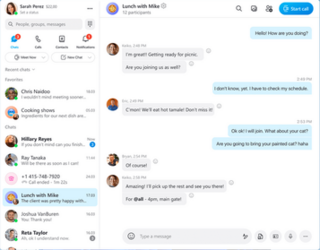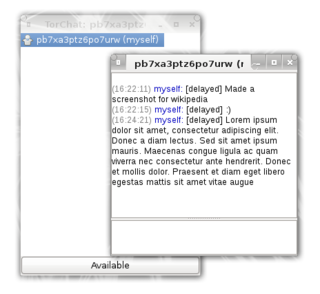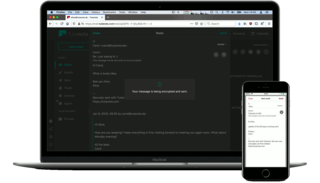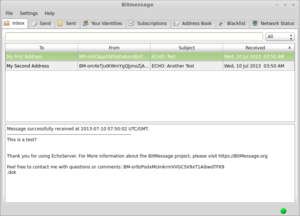Pretty Good Privacy (PGP) is an encryption program that provides cryptographic privacy and authentication for data communication. PGP is used for signing, encrypting, and decrypting texts, e-mails, files, directories, and whole disk partitions and to increase the security of e-mail communications. Phil Zimmermann developed PGP in 1991.

An email client, email reader or, more formally, message user agent (MUA) or mail user agent is a computer program used to access and manage a user's email.

Instant messaging (IM) technology is a type of online chat allowing real-time text transmission over the Internet or another computer network. Messages are typically transmitted between two or more parties, when each user inputs text and triggers a transmission to the recipient(s), who are all connected on a common network. It differs from email in that conversations over instant messaging happen in real-time. Most modern IM applications use push technology and also add other features such as emojis, file transfer, chatbots, voice over IP, or video chat capabilities.

Skype is a proprietary telecommunications application operated by Skype Technologies, a division of Microsoft, best known for VoIP-based videotelephony, videoconferencing and voice calls. It also has instant messaging, file transfer, debit-based calls to landline and mobile telephones, and other features. Skype is available on various desktop, mobile, and video game console platforms.
An anonymous P2P communication system is a peer-to-peer distributed application in which the nodes, which are used to share resources, or participants are anonymous or pseudonymous. Anonymity of participants is usually achieved by special routing overlay networks that hide the physical location of each node from other participants.
The Invisible Internet Project (I2P) is an anonymous network layer that allows for censorship-resistant, peer-to-peer communication. Anonymous connections are achieved by encrypting the user's traffic, and sending it through a volunteer-run network of roughly 55,000 computers distributed around the world. Given the high number of possible paths the traffic can transit, a third party watching a full connection is unlikely. The software that implements this layer is called an "I2P router", and a computer running I2P is called an "I2P node". I2P is free and open sourced, and is published under multiple licenses.

Internet security is a branch of computer security. It encompasses the Internet, browser security, web site security, and network security as it applies to other applications or operating systems as a whole. Its objective is to establish rules and measures to use against attacks over the Internet. The Internet is an inherently insecure channel for information exchange, with high risk of intrusion or fraud, such as phishing, online viruses, trojans, ransomware and worms.
End-to-end encryption (E2EE) is a private communication system, only communicating users can participate, no adversary nor eavesdropper can interfere, not the communication system provider, telecom providers, Internet providers, nor malicious actors, only communicating users can access the cryptographic keys needed to converse.
Email privacy is a broad topic dealing with issues of unauthorized access to, and inspection of, electronic mail, or unauthorized tracking when a user reads an email. This unauthorized access can happen while an email is in transit, as well as when it is stored on email servers or on a user's computer, or when the user reads the message. In countries with a constitutional guarantee of the secrecy of correspondence, whether email can be equated with letters—therefore having legal protection from all forms of eavesdropping—is disputed because of the very nature of email.Morrison, Steven R. "What the Cops Can't Do, Internet Service Providers Can: Preserving Privacy in Email Contents". Va. JL & Tech.</ref>
Cryptovirology refers to the use of cryptography to devise particularly powerful malware, such as ransomware and asymmetric backdoors. Traditionally, cryptography and its applications are defensive in nature, and provide privacy, authentication, and security to users. Cryptovirology employs a twist on cryptography, showing that it can also be used offensively. It can be used to mount extortion based attacks that cause loss of access to information, loss of confidentiality, and information leakage, tasks which cryptography typically prevents.

In cryptography, a nonce is an arbitrary number that can be used just once in a cryptographic communication. It is often a random or pseudo-random number issued in an authentication protocol to ensure that old communications cannot be reused in replay attacks. They can also be useful as initialization vectors and in cryptographic hash functions.
Email encryption is encryption of email messages to protect the content from being read by entities other than the intended recipients. Email encryption may also include authentication.

TorChat was a peer-to-peer anonymous instant messenger that used Tor onion services as its underlying network. It provided cryptographically secure text messaging and file transfers. The characteristics of Tor's onion services ensure that all traffic between the clients is encrypted and that it is very difficult to tell who is communicating with whom and where a given client is physically located.
Silent Circle is an encrypted communications firm based in Washington DC. Silent Circle provides multi-platform secure communication services for mobile devices and desktop. Launched October 16, 2012, the company operates under a subscription business model. The encryption part of the software used is free software/open source and peer-reviewed. For the remaining parts of Silent Phone and Silent Text, the source code is available on GitHub, but under proprietary software licenses.
Secure instant messaging is a form of instant messaging. Both terms refer to an informal means for computer users to exchange messages commonly referred to as "chats". Instant messaging can be compared to texting as opposed to making a mobile phone call. In the case of messaging, it is like the short form of emailing. Secure instant messaging is a specialized form of instant messaging that along with other differences, encrypts and decrypts the contents of the messages such that only the actual users can understand them.

Twister is a decentralised, experimental peer-to-peer microblogging program. The system uses end-to-end encryption to safeguard communications. It is based on both BitTorrent- and Bitcoin-like protocols and has been likened to a distributed version of Twitter.
TextSecure was an encrypted messaging application for Android that was developed from 2010 to 2015. It was a predecessor to Signal and the first application to use the Signal Protocol, which has since been implemented into WhatsApp and other applications. TextSecure used end-to-end encryption to secure the transmission of text messages, group messages, attachments and media messages to other TextSecure users.

Attempts, unofficially dubbed the "Crypto Wars", have been made by the United States (US) and allied governments to limit the public's and foreign nations' access to cryptography strong enough to thwart decryption by national intelligence agencies, especially the National Security Agency (NSA).

Tutanota is an end-to-end encrypted email app and a freemium secure email service. The service is advertisement-free; it relies on donations and premium subscriptions. As of March 2017, Tutanota's owners claimed to have over 2 million users of the product.

Session is a cross-platform end-to-end encrypted instant messaging application, focused on confidentiality and anonymity for the user. It is developed by The Oxen Project under the non-profit Oxen Privacy Tech Foundation. It uses a blockchain-based decentralized network for transmission. Users can send one-to-one and group messages, which can include files, voice notes, images and videos.










